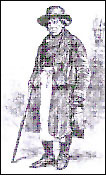|
Burton Latimer Militia -
Introduction
From the Anglo-Saxon period, able-bodied men were liable for military service as a local home defence force. Originally owners of property were charged with the provision of horses, arms and men, in accordance with the value of their property, but this liability was removed later from the individual to the parish. Each county had to provide a quota of men for militia service, the lord lieutenant of each county and his deputies were responsible for raising these men and it was the duty of the parish constable to provide the names of the eligible men in his village.
The English Militia was a force raised for the defence of the realm against invasion or rebellion, it was not liable for service overseas. The Churchwarden’s accounts of Burton Latimer record several occasions when the butts needed renovating. They were used for the soldiers training and were made of a bank of soil and turf for target practice. It is obvious from the accounts that periodically the town’s musket (did we only have one?) had to be sent away to be repaired “when it was broken” and at another time a new stand was made. When the men were sent to train at
Kettering
, transport was needed for the armour for the soldiers, unfortunately we are not told what this armour was. According to the constables accounts of Burton Latimer, in 1638 the militia went for their first training at
Kettering
and it cost the town £1.10.08, quite a large sum at this time for a small village. Richard Chichely was paid 1s for carrying the armour to
Kettering
and returning it. Then 4s.3d was paid out for powder and match at the second training and 3s.10d for powder and match for the third training. The fourth training cost the town 1s.2d for powder and match and the fifth training cost only pennies, presumably the men had enough powder and match to last them. The sixth training cost 5s.6d and the armour again had to be carried to
Kettering
and returned at the cost of a shilling. When the soldiers trained the seventh time the cost was 6s , it must be remembered that this was the time of Charles I’s war with
Scotland
and it was necessary that the local militia was ready when needed. Several maimed soldiers passed through the town at this time and were given a bed and food before they were sent on their way.
After the English Civil War the militia was in abeyance but was revived in 1757. The men eligible for service were able-bodied and between the ages of 18 and 45 years. There were exemptions, for example, peers of the realm, clergymen, articled clerks, apprentices, seamen and parish constables, also poor men who had three or more children born in wedlock (reduced to one in 1786),and of course lame men. Service was for three years and determined by ballot, but any man whose name was drawn, and could afford to, could pay another man to stand in for him and would usually do so.
Northamptonshire militia men were trained for 28 days annually usually at
Northampton
and were paid according to a scale laid down by Parliament. In 1771 because of an epidemic of smallpox at
Northampton
the men were divided into two camps, one at Wellingborough and the other at
Kettering
. The training usually took place in May and June, this way it did not affect the men being away from home for the gathering in of the harvest.
To find suitable men for the militia the parish constable needed to produce a list of all the men living within his parish between the ages of 18 and 45 years, noting their ranks and occupations, and if any had infirmities or any other reason why they should not serve. The list was then displayed on the door of the parish church for the space of a Sunday morning. Any person who thought his name should not have been included or knew of someone whose name had been omitted, was entitled to appeal.
On the following pages are the lists of men published by the parish constables of Burton Latimer in 1762, 1774, 1778 and 1781. Click on one of the links at the top or bottom of the page.
|

